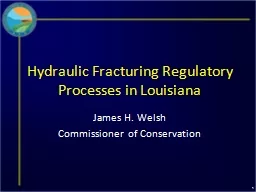

James H Welsh Commissioner of Conservation 2 Areas of Current amp Potential Activity Tuscaloosa Marine Shale Haynesville Shale BROWN DENSE Regulatory Goals Resource Conservation Sustainability ID: 541339
Download Presentation The PPT/PDF document "1 Hydraulic Fracturing Regulatory Proces..." is the property of its rightful owner. Permission is granted to download and print the materials on this web site for personal, non-commercial use only, and to display it on your personal computer provided you do not modify the materials and that you retain all copyright notices contained in the materials. By downloading content from our website, you accept the terms of this agreement.
Slide1
1
Hydraulic Fracturing Regulatory Processes in Louisiana
James H. Welsh
Commissioner of ConservationSlide2
2Areas of Current & Potential Activity
Tuscaloosa Marine Shale
Haynesville Shale
BROWN DENSESlide3
Regulatory GoalsResource Conservation / Sustainability Waste MinimizationPollution PreventionTransparencyAwareness / Surveillance3Slide4
Regulatory ProcessesWater Source Management / EvaluationWork PermitsWell Construction RequirementsWaste Management / Disposal RequirementsFracturing Fluid DisclosureInspection & Enforcement4Slide5
Water Sources – Surface WaterUse of surface water is encouraged.Cooperative Endeavor Agreements may be created through DNR – Office of Mineral Resources (OMR) for the use of running surface water. (Act 955 of 2010)Application process involves assessing the environmental/ecological impacts and economic benefits of surface water use.5Slide6
Water Sources – Ground WaterNotice is required prior to installation of new wells and prior to a change in use of existing wells for evaluation purposes.Orders may be issued to collect information, conduct metering, impose well spacing requirements, or limit production.Information may be used to establish areas of groundwater concern.6Slide7
Water Sources – OtherCertain E&P Wastes may be used as a frac fluid component in limited cases.Promotes both waste minimization and resource conservation.7Slide8
Water Sources – ReportingWater sources and volumes must be reported for wells that are hydraulically fractured.Reporting is accomplished by filing Supplemental Page 3 of the Well History and Work Resumé Report (Form WH-1) following well completion.8Slide9
Water Use Statistics
Reported Usage from 10/1/2009 to
2/23/2012
Source
Volume (Gallons)
Frac Groundwater
1,230,712,693
Frac Surface Water
8,223,152,516
Drilling Rig Groundwater Supply
879,649,632
Drilling Rig Surface Water Supply
157,839,504
Other Groundwater
155,545,829
Other Surface Water,
39,007,638
Frac Stages
22,338
Total Frac Water Used (gallons)
9,453,865,209
Volume per Frac Stage (gallons)
423,219
Average Frac Stages per Well
11.4
Average Water Use per Well (gallons)
5,454,777
Average Frac Water Use per Well (gallons)
4,825,863
9
Water Usage Data for
1959
Haynesville
Shale Natural Gas WellsSlide10
Work PermitsA work permit application (Form DM-4R) must be approved prior to conducting fracturing operations.Process allows for OC inspection of operations.10Slide11
Well Construction RequirementsUse of multiple cemented casing stringsMinimum setting depth to protect USDWPost-installation pressure testing11Slide12
Waste ManagementE&P Waste regulations ensure proper disposal to minimize environmental impacts of resource development.Manifest and reporting systems ensure transparency and accountability. Waste Management options include:Onsite disposalWell injectionCommercial disposalRecycling in limited cases12Slide13
13Slide14
Fracturing Fluid Disclosure Types and volumes (in gal.) of hydraulic fracturing fluidList of additives used List of chemical ingredients subject to requirements of 29 CFR 1910.1200(g)(2)Maximum ingredient concentration within the additiveIngredients and concentrations of proprietary chemicals are not required.Required information may be reported to Frac Focus website.
14Slide15
Fracturing Fluid Disclosure Requirements by State15Slide16
Inspection & Rule Enforcement16Periodic visual inspections of wells are conducted during all phases of development Regulatory violations result in the issuance of Compliance Orders to the responsible party requiring corrective actions.Possible enforcement actions includeLevy of Civil PenaltiesSuspension of authority to sell oilWithholding permits“Orphaning” Declaration Slide17
STRONGER, Inc. is a nonprofit multi-stakeholder organization which measures state oil and gas waste management programs against a set of Guidelines developed and agreed to by all the participating parties.A Louisiana Review focusing on hydraulic fracturing regulatory practices was conducted in November 2010; Findings were issued in March 2011.Positive Assessments of Louisiana’s Regulatory Framework:Proactive conservation of groundwater resource use.Waste water recycling program.Public outreach and education.Waste disposal regulations.Areas for Improvement:Updated Casing and Cementing Requirements. (IN PROGRESS)More systematic training of Inspectors. (IN PROGRESS)Require the reporting of hydraulic fracturing information including component constituents of frac fluid
. (COMPLETED)
17
STRONGER ReviewSlide18
Potential Future Rule Changes18Frac Fluid DisclosureDisclosure requirements tied to “Right to Know” federal law instead of OSHA safety communication rules.Casing and CementingClear design objectivesFormation Integrity TestsCement evaluation following prolonged drillingLiner seal testing Cement top verification in limited circumstances